LECTURES AND TALKS
David Winpenny talks on a range of subjects, including architectural and landscape history, country houses, pyramids and follies - and about the first ascent of the Matterhorn.
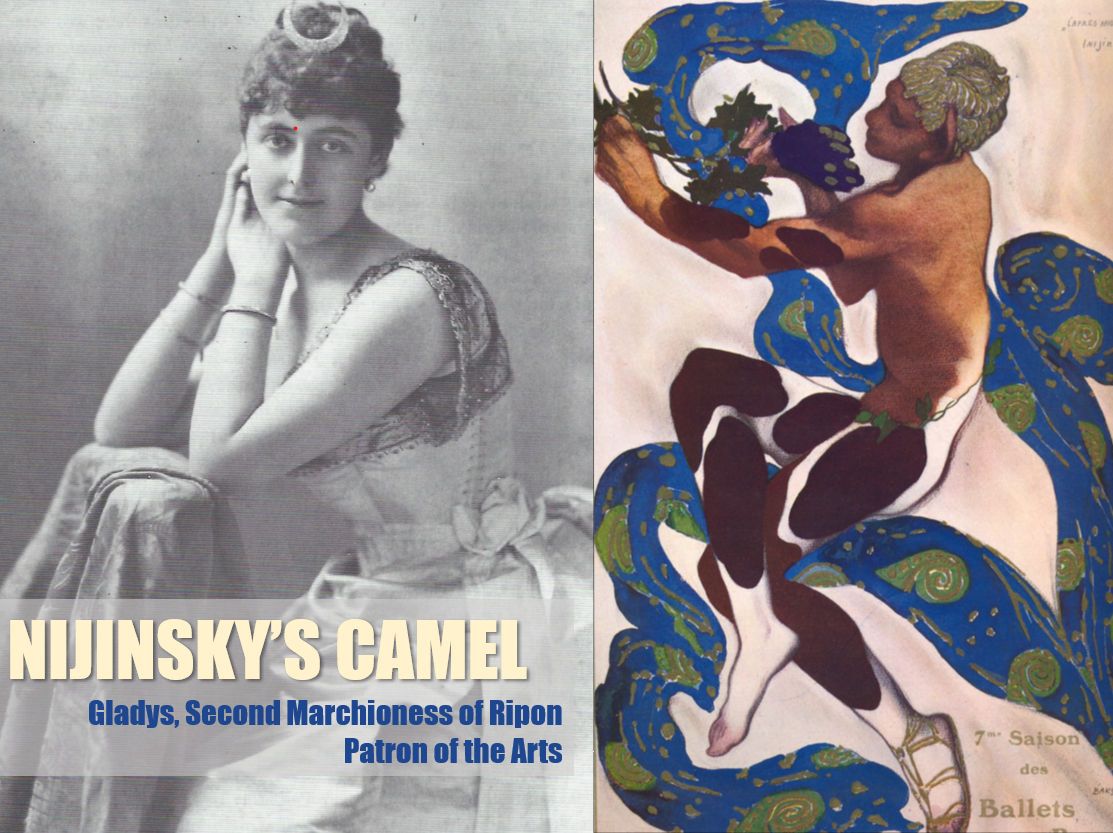
NIJINSKY'S CAMEL -
Gladys, Second Marchioness of Ripon and Patron of the Arts
Gladys de Grey, later Marchioness of Ripon, was a late 19th-century 'fast ' woman, who eventually married 'the greatest shot in England'. She rescued a moribund Covernty Garden Opera and introduced the Ballet Russe to Britain.
Longer synopsis
Gladys, Second Marchioness of Ripon and Patron of the Arts
Gladys de Grey, later Marchioness of Ripon, was a late 19th-century 'fast ' woman, who eventually married 'the greatest shot in England'. She rescued a moribund Covernty Garden Opera and introduced the Ballet Russe to Britain.
Longer synopsis

UP TO A POINT -
Pyramids
in Britain and Ireland
Looking at the many structures in Britain buiit in the form of a pyramid - from monuments to offices, follies to garden ornaments.
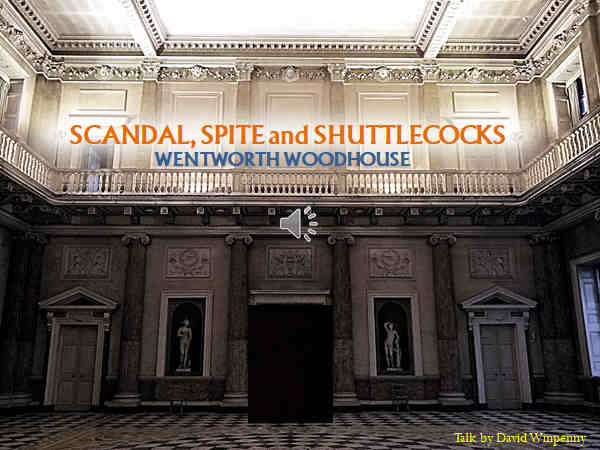
SCANDAL, SPITE AND SHUTTLECOCKS - Wentworth Woodhouse
The history and architecture of Wentworth Woodhouse, Britain's largest and least-known country house - and its dysfunctional families

A VERY DANGEROUS WORK’ - Gilbert Scott and the restoration of Ripon Cathedral
The life of architect Gilbert Scott and, using Ripon Cathedral
as an example, an outline of how he rescued a cathedral from collapse and restored it to its current state.

EDWIN LUTYENS - 'A Singular and Delightful Man'
: The life and work of the most famous British architect of the 20th century, from his early country houses, through his work in New Delhi to his final years.

OPENING THE DOORS - A brief history of country house visiting
: how from the earliest days large houses and castles were open to guests, and how, over the centuries, guests became visitors and then tourists as owners adapted to new demands and new economic circumstances.

SCIENCE AND SAND : Piazzi Smyth, astronomer and pyramid fanatic
: Smyth, who undertook serious scientific research into spectrospcopy and meteorology, was a pioneer of photography - and believed that the Great Pyramid held the secrets of the universe.

HACKFALL - A landscape back from the brink
: Hackfall, recently rescued from a century of neglect, is an 18th-century Romantic garden of trees, water and follies, designed by the creator of nearby Studley Royal in North Yorkshire.

ECCENTRICS, EXOTICS AND ERRATICS - Buildings in gardens
: looking at garden structures in a variety of styles, including Chinese, Japanese, Russian, Hindu, Egyptian, Druidic and Prehistoric.
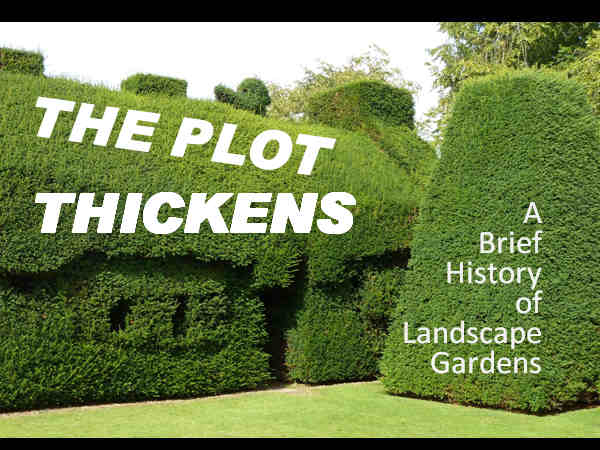
THE PLOT THICKENS - A brief history of landscape gardens
: from prehistory to the 21st century.
COPYING THE CLASSICAL - Garden buildings in the Greek and Roman styles
: the classically-inspired buildings that play such an important role in 18th and 19th century gardens – in styles from the classical to the dotty.

GOING WITH THE FLOW - Garden cascades, fountains, waterfalls and lakes
: water has always played an important part in gardens, from the days of the ancient Egyptians to the 21st century.
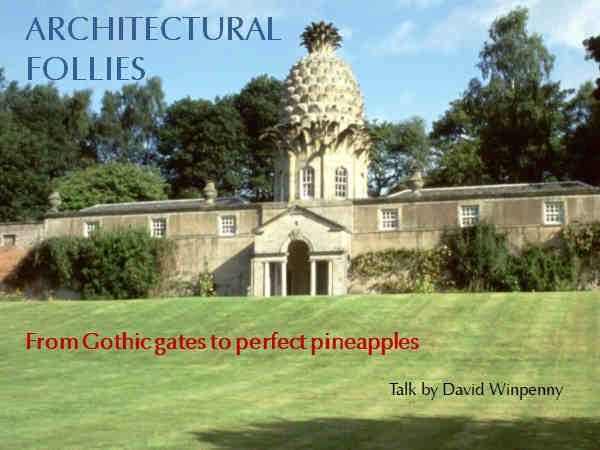
ARCHITECTURAL FOLLIES - From Gothic Gates to Perfect Pineapples
: buildings have always expressed the personality and whims of their builders, sometimes in the most unexpected ways.

PAINTING WITH LIGHT – English stained glass : the development of stained glass from the time of Bede to the 21st century.

HENRY HOLIDAY – Stained glass and more
: Henry Holiday was a painter, socialist, dress reformer, Wagnerite - and stained glass artist.
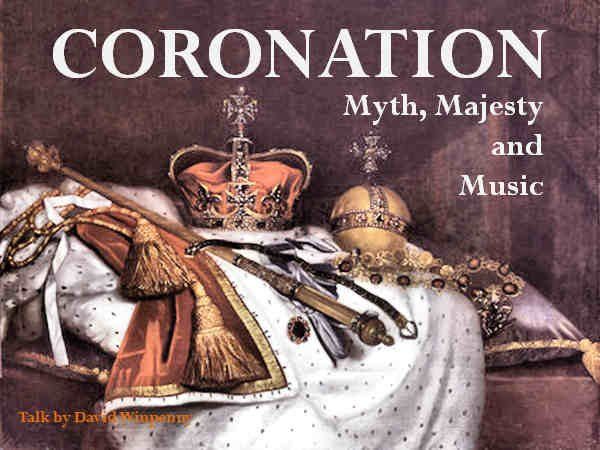
CORONATION - Myth, majesty and music
: the development of British coronations and their music from the 8th century to the present.
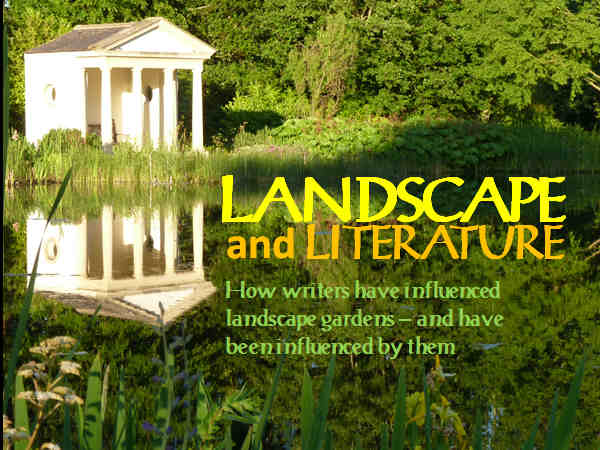
LANDSCAPE AND LITERATURE
: how writers responded to landscape, and how landscape gardeners took their cues from literature.

HOW TO WRITE A FAKE - Literary forgeries from Pepin the Short to Hitler : a wide range of literary forgeries, including the poems of Ossian and the Shakespeare forgeries of John Henry Ireland.
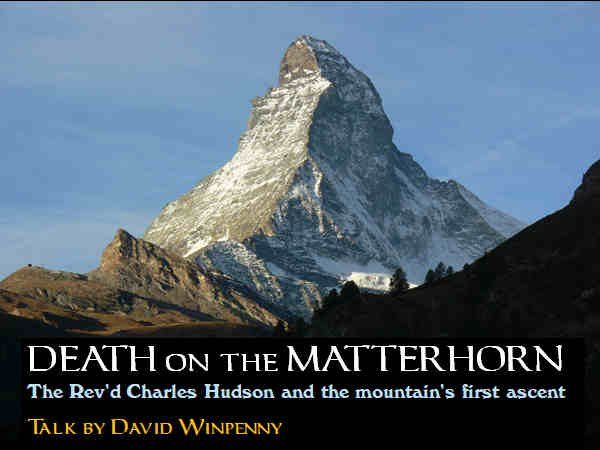
DEATH ON THE MATTERHORN - The Rev'd Charles Hudson and the mountain's first ascent
: the story of the success and failure of a party of English climbers in 1865 (includes excerpts from a feature film made in 1936 about the event).
TALKS ABOUT PLACES
ETERNAL SPRING – Growing In The Azores
The generous climate of the Azores mean that it has become ‘the land where everything grows’ – from bananas (the islands’ biggest export), passion fruit and pineapples to potatoes and sugar beet. And there is also cheese and wine, timber and even the cultivation of seaweed – not to mention taro, custard apples and candlenut.
HIDDEN GARDENS OF THE AZORES
Among the natural beauties of the islands of the Azores you can find hidden gardens where over more than two centuries owners and their gardeners – a surprising number from Britain – have enhanced wooded valleys, extinct caters and steep hillsides with carefully-laid-out walks and an abundance of native and more exotic species.
The generous climate of the Azores mean that it has become ‘the land where everything grows’ – from bananas (the islands’ biggest export), passion fruit and pineapples to potatoes and sugar beet. And there is also cheese and wine, timber and even the cultivation of seaweed – not to mention taro, custard apples and candlenut.
HIDDEN GARDENS OF THE AZORES
Among the natural beauties of the islands of the Azores you can find hidden gardens where over more than two centuries owners and their gardeners – a surprising number from Britain – have enhanced wooded valleys, extinct caters and steep hillsides with carefully-laid-out walks and an abundance of native and more exotic species.
TERRACES AND LEVADAS – Madeira’s answer to Nature
Madeira produces much more than its wine. Its stone-lined steep terraces, irrigated by the network of waterways called levadas, produce Mediterranean fruits at low level, apples, cherries and plums in the deep valleys, flowers for export and plentiful willow for basket weaving – although less than seven percent of the land is used for commercial growing, against almost half under forest.
GREEN ESCAPES – Madeira’s Gardens
From the ancient Dragon Trees to the latest orchid hybrids, the gardens of Madeira have something for everyone. On the hill above the Botanic Gardens, famous for their photogenic checkerboard planting, the Monte Palace Gardens include Japanese and Chinese sections, while nearer Funchal’s centre are public and private parks that offer green oases in the busy town.
Madeira produces much more than its wine. Its stone-lined steep terraces, irrigated by the network of waterways called levadas, produce Mediterranean fruits at low level, apples, cherries and plums in the deep valleys, flowers for export and plentiful willow for basket weaving – although less than seven percent of the land is used for commercial growing, against almost half under forest.
GREEN ESCAPES – Madeira’s Gardens
From the ancient Dragon Trees to the latest orchid hybrids, the gardens of Madeira have something for everyone. On the hill above the Botanic Gardens, famous for their photogenic checkerboard planting, the Monte Palace Gardens include Japanese and Chinese sections, while nearer Funchal’s centre are public and private parks that offer green oases in the busy town.
LISBON'S BUILDINGS
Lisbon offers architecture from all ages and in all styles, from the medieval castle of S Jorge and the Sé (cathedral) to the 21st century. In the 19th, Eiffel (of Tower fame) worked here, but before him there were the gems of the elaborate medieval Manueline style of Gothic, including the monastery at Belém, and the monuments of the time of the Portuguese empire and the explorers.
Lisbon offers architecture from all ages and in all styles, from the medieval castle of S Jorge and the Sé (cathedral) to the 21st century. In the 19th, Eiffel (of Tower fame) worked here, but before him there were the gems of the elaborate medieval Manueline style of Gothic, including the monastery at Belém, and the monuments of the time of the Portuguese empire and the explorers.
MOROCCO, MELTING POINT OF ARCHITECTURAL STYLES
From ancient times to the present day, Morocco has absorbed many styles of architecture, from the primitive mud structures of the Berbers, through the distinctive patterns of Arabic art to the Art Deco of French and Italian rulers. This talk looks at how Moroccan buildings changed – and how they often influenced Iberian European building, too.
From ancient times to the present day, Morocco has absorbed many styles of architecture, from the primitive mud structures of the Berbers, through the distinctive patterns of Arabic art to the Art Deco of French and Italian rulers. This talk looks at how Moroccan buildings changed – and how they often influenced Iberian European building, too.
MALAGA - ROMANS, RELIGION, MOORS AND MODERNITY
From its Roman theatre and ruins, through its impressive cathedral and the hilltop Alcazaba fort to the Picasso Museum and the Pompidou Centre, Malaga has a long history of remarkable architecture. This talk introduces the various styles and sites a visitor can explore.
GIBRALTAR AND CEUTA - A FOOTHOLD IN TWO CONTINENTS
The Britishness of Gibraltar – red telephone boxes, Regency ironwork balconies and English street names – is only skin deep. Over the centuries it has absorbed Roman, Arabic, Spanish and Italian influences alongside the British. Ceuta, opposite on the African shore, is a Spanish enclave successively influenced by Carthaginians, Greeks, Romans and Byzantines, before Portugal and then Spain took it over. This talk looks at the buildings of both settlements.
From its Roman theatre and ruins, through its impressive cathedral and the hilltop Alcazaba fort to the Picasso Museum and the Pompidou Centre, Malaga has a long history of remarkable architecture. This talk introduces the various styles and sites a visitor can explore.
GIBRALTAR AND CEUTA - A FOOTHOLD IN TWO CONTINENTS
The Britishness of Gibraltar – red telephone boxes, Regency ironwork balconies and English street names – is only skin deep. Over the centuries it has absorbed Roman, Arabic, Spanish and Italian influences alongside the British. Ceuta, opposite on the African shore, is a Spanish enclave successively influenced by Carthaginians, Greeks, Romans and Byzantines, before Portugal and then Spain took it over. This talk looks at the buildings of both settlements.
LIVERPOOL BELOW AND ABOVE GROUND
From the tunnels under the River Mersey to the heights of the cathedral tower, a look at some of Liverpool's iconic buildings.
From the tunnels under the River Mersey to the heights of the cathedral tower, a look at some of Liverpool's iconic buildings.
BELFAST’S BUILDINGS
The long and often bitter history of Belfast can be seen in its buildings; we’ll look at the city’s origins, at the effect that invasions from both Scotland and England had on the city, and at its heyday as a merchant and industrial city in the 18th and 19th centuries, including the famous shipyards. Irish Home rule agitation and the creation of the Free State in 1922 were as much troubled time as the IRA agitation from the 1970s; all these – and the renewed prosperity since the Good Friday Agreement had their effect on Belfast’s buildings.
The long and often bitter history of Belfast can be seen in its buildings; we’ll look at the city’s origins, at the effect that invasions from both Scotland and England had on the city, and at its heyday as a merchant and industrial city in the 18th and 19th centuries, including the famous shipyards. Irish Home rule agitation and the creation of the Free State in 1922 were as much troubled time as the IRA agitation from the 1970s; all these – and the renewed prosperity since the Good Friday Agreement had their effect on Belfast’s buildings.
MULLING IT OVER
A look at the importance of Mull’s past, from the stone age, though the Celtic Christianity of Iona, the turbulence of the Middle Ages and the bloody conflict of the Killing Times, to the Clearances and the Island’s strategic role in World War II to the present-day welcome for its many visitors.
A look at the importance of Mull’s past, from the stone age, though the Celtic Christianity of Iona, the turbulence of the Middle Ages and the bloody conflict of the Killing Times, to the Clearances and the Island’s strategic role in World War II to the present-day welcome for its many visitors.
LEWIS AND HARRIS - A CONTRAST
Two names, two landscapes – one Island. Moorland Lewis has prehistoric Callanish stone circle and the Butt of Lewis lighthouse; while scenic, rocky Harris, has attractive settlements and some fascinating monuments.
Two names, two landscapes – one Island. Moorland Lewis has prehistoric Callanish stone circle and the Butt of Lewis lighthouse; while scenic, rocky Harris, has attractive settlements and some fascinating monuments.
STONES OF ORKNEY
The standing stones and tombs of Orkney are a World Heritage Site. Orkney stone lent itself to these prehistoric monuments, and on through Bronze and Iron ages, to Celtic brochs and the buildings of the time of the Sagas. Medieval Orcadians built castles and churches (and a cathedral in Kirkwall), while in the generally more-peaceful 18th and 19th centuries came country houses. And the two World Wars also affected the buildings of Orkney – including an Italian Chapel created from a Nissan Hut.
The standing stones and tombs of Orkney are a World Heritage Site. Orkney stone lent itself to these prehistoric monuments, and on through Bronze and Iron ages, to Celtic brochs and the buildings of the time of the Sagas. Medieval Orcadians built castles and churches (and a cathedral in Kirkwall), while in the generally more-peaceful 18th and 19th centuries came country houses. And the two World Wars also affected the buildings of Orkney – including an Italian Chapel created from a Nissan Hut.
THE UNIQUENESS OF SHETLAND
A look at what makes Shetland different from the rest of Britain – from its Viking Heritage and role on the sagas to its modern role in North Sea exploration – and its future. We’ll look at landscape and building, as well as some famous Shetlanders.
A look at what makes Shetland different from the rest of Britain – from its Viking Heritage and role on the sagas to its modern role in North Sea exploration – and its future. We’ll look at landscape and building, as well as some famous Shetlanders.
FASCINATING FAROES
Tunnels linking the islands, a tiny parliament, a long Scandinavian heritage and friendly people combine in the modern, vibrant Faroe Islands – the communities of Torshavn and Klaksvick sit among dramatic scenery6
ASPECTS OF ICELAND
A look Iceland, from its Sagas, among the oldest of European stories, full of love and vengeance, suffering and heroism, to its vibrant p-resent, and some of its iconic buildings, from the grandeur of Reykjavik’s Halgrimmskirkja and Akureyri’s cathedral to wooden houses and Iceland’s only windmill.
A look Iceland, from its Sagas, among the oldest of European stories, full of love and vengeance, suffering and heroism, to its vibrant p-resent, and some of its iconic buildings, from the grandeur of Reykjavik’s Halgrimmskirkja and Akureyri’s cathedral to wooden houses and Iceland’s only windmill.
KEUKENHOF – FROM KITCHEN GARDEN TO THE ‘GARDEN OF EUROPE’
From its humble beginnings as the garden supplying food for Teylingen Castle, Keukenhof has blossomed into one of Europe’s most-famous and most-visited gardens. Its drifts of colourful tulips are famous – and Dutch ‘tulipomania’ didn’t die out after a 17th century craze – but Keukenhof is home to many other interesting plants and flowers, all laid out in an ‘English-style’ garden.
From its humble beginnings as the garden supplying food for Teylingen Castle, Keukenhof has blossomed into one of Europe’s most-famous and most-visited gardens. Its drifts of colourful tulips are famous – and Dutch ‘tulipomania’ didn’t die out after a 17th century craze – but Keukenhof is home to many other interesting plants and flowers, all laid out in an ‘English-style’ garden.
A SCILLONIAN PARADISE – TRESCO ABBEY GARDENS
Tresco, second-largest of the Isles of Scilly, has one of the world’s great gardens, set around the remains of Tesco Abbey and the Victorian owner’s mansion. Warmed by the Gulf Stream, the garden hosts thousands of colourful plants from the southern hemisphere and subtropics, planted with an eye to beauty. Discover unusual plantings – as well as red squirrels and ships’ figureheads.
Tresco, second-largest of the Isles of Scilly, has one of the world’s great gardens, set around the remains of Tesco Abbey and the Victorian owner’s mansion. Warmed by the Gulf Stream, the garden hosts thousands of colourful plants from the southern hemisphere and subtropics, planted with an eye to beauty. Discover unusual plantings – as well as red squirrels and ships’ figureheads.
